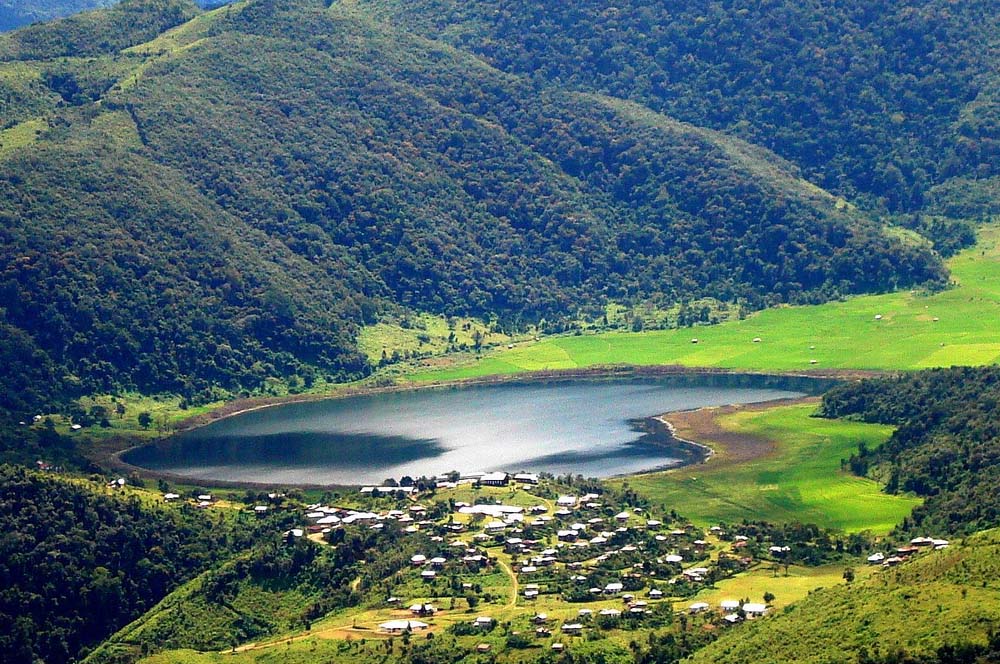A natural lake in northern Chin State is steadily luring number of tourists. But is it worth the fuss, asks James Fable.
Whispers of the mystical heart-shaped Rih lake in northeastern Chin State have gradually spread and got tourists asking questions. The 2017 Lonely Planet even placed it tenth in its top 10 Myanmar destinations, rating it more highly than the popular Chin attractions of Mt Victoria and Mindat.
But is Rih lake really worth trekking over to the Indian border for, or are the stories just romantic?
Patience is a virtue in northern Chin State, where few roads are concreted and lengthy delays common. The only way to reach Rihkhawdar, the closest town to Rih Lake, is via Tiddim, which is accessed either from Kalawmyo in northern Sagaing State or from Hakha, the Chin Capital. From Tiddim the journey takes four hours. There are also buses to Rihkhawdar from Kalaymyo but nine consecutive hours of bumpy mountains roads are not for everyone. If you are travelling in the dry season, bring a dust mask.
Like many border towns, Rihkhawdar boasts a fascinating dynamic of organized, cross-boundaries chaos and diverse, multilingual residents- many of whom are of Indian or Chinese descent. The local language is Mizo, and 100-yard bridge separates Rihkhawdar from the Indian State of Mizoram.
Despite objection from Presbyterian Church, the prohibition of alcohol in Mizoram was repealed in 2015. Until then, Mizo people had to cross into Myanmar for their fill and return before the border shut at 6 pm – or stumble back across the river if they had drunk one too many. Some Mizo still prefer to booze in Rihkhawdar, where the drink prices are given in Indian Rupees.
The only Rihkhawdar guesthouse that foreigners are permitted stay in is the clean and comfortable Rih Shwe Pyi. To walk there would be an uphill struggle, but the journey back offers some pleasant views.
Rih Lake sits within 545 acres of protected public forest and is home to a colorful variety of attractive birds. The name derives from a Mizo birds. The name derives from a Mizo folktale. Rih-I had a younger sister who was murdered by her father in their stepmother’s orders, only to be resurrected by a helping spirit. Rih-I then used the same spell to turn herself into a water body that become Rih Lake.
Much as Chin communities in Matupi consider Bungtla Waterfall to be part of their God-given heritage, Rih Lake holds huge spiritual significance for the Mizo. In ancient animist tradition, Rih Lake is a gateway to Piairal, the Mizo version of paradise. Although both Chin and Mizoram were heavily targeted by Christian missionaries, Rih lake retained its mystical status through the syncretism of Piairal with Christian heaven. The lake remains a pilgrimage site for Indian and Myanmar Mizo.
Rih Lake today is a favorite local hang-out, complimented by the lakeside restaurant. After a swim in its cool water, stunning a visiting Indian school class, I was dragged into countless selfies with the teachers. The headmaster, who stank of betel and whisky, insisted on me being half naked in all the pictures. Eventually he was forced to join a class photo, so I grabbed my stuff and escaped.
I headed to a nearby hill that overlooked the lake and whose hilltop happened to be occupied by a Tatmadaw station. Fortunately, the soldiers were friendly and led me to a small wooden balcony poised precariously over a precipice: the viewpoint. I politely refused a cup of army tea and chat about football with the commanding officer, but the offer hadn’t been optional. Curiously there is an instant tea mix made exclusively for the Tamadaw – which they make real pride in. It takes like any other instant tea mix.
The views from here were fantastic, Rih lake itself was somewhat underwhelming. Although the heart-shaped outline was romantic, the lake itself was fairly small-just one-mile long and half a mile wide- and the surrounding crops were dead and brown.
Had I visited in the monsoon season- when the lake is encircled by mesmerizing, emerald rice paddies-it may have been a love story. But travelling in Chin State in the Monsoon season is perilous: the region becomes prone to landslides and the mountain roads turns into bugs. I’ve personally seen a four-wheel drive truck tip over just a meter from the edge. That’s when I decided to leave Chin State until the dry season.
So, is Rih Lake worth the trek, or has it been overly romanticized? If you are heading to northern Chin State anyway, you may as well visit. But unless you are willing to risk muddy mountain roads and landslides, don’t bother travelling across half the country for it. There are other destinations in Myanmar that would make my top 10 before Rih Lake, and I suspect the Lonely Planet only included it in theirs because it is their sole one in Chin State.
Resource: Myanmore Magazine, April 2018
Author: James Fable







Comments are closed.